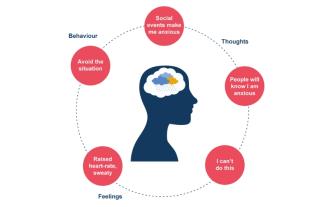Stammering, anxiety, CBT & me

Keith Gore writes about how anxiety used to stop him from doing lots of things. Since being introduced to cognitive behaviour therapy, however, all that has changed.
It's the caveman's fault
Imagine you're a caveman out hunting with your spear. Not only do you need to be fast to catch your prey, you also need to be quick to escape becoming the prey yourself.
Your heart beats quicker, you're more alert, your fear level is higher, you're getting ready to sprint at any moment, looking at your prey whilst peering back to watch for predators.
Anxiety is a good trait — the chilled out caveman gets eaten.
Modern man
The part of your brain that controls anxiety hasn't evolved since caveman times. The anxiety triggers are still the same, but the environment is different. Today's predators are the ice-breakers at meetings, the speeches at weddings and meeting your partner's parents for the first time. The prey is the successful job interview, talking to that cute girl for the first time and telling a joke without struggling on the punchline.

This diagram demonstrates what used to happen with my 'anxiety cycle'. In a speaking situation I experienced negative thoughts, then negative feelings. These were so strong that I avoided the situation, reinforcing my fear.
Here's an example of how this played out in the past. I was in town and was hungry so decided to go to Subway, the fast food place. But I suddenly thought, "what if my speech won't come out? It was really embarrassing when it happened last time." I then thought about picking up a sandwich in a shop instead so I wouldn't have to give my order. But I thought about how frustrating this was, something so small stressing me out. So I decided to go to Subway.
The more worried I am about stammering, the more it happens. The bigger and more important the event, the bigger the fear, which then affects my speech.
All of a sudden I was walking fast; my hands were sweaty, my heart rate had sped up and I was struggling to breathe. I noticed my feelings: the fear was taking over and my chest was tightening up. Once outside Subway I saw the queue, turned and went to a shop instead. I walked home feeling so deflated. I knew the queue was an excuse to make myself feel better about my avoidance. This whole experience was then locked away in my subconscious, ready to be reopened upon my next trip there.
For me, stammering was my greatest fear. The more worried I am about stammering, the more it happens. The bigger and more important the event, the bigger the fear, which then affects my speech.
How CBT has helped
I was having a hard time with my anxiety, mostly because of my speech and how I thought it was perceived. It stopped me from doing a lot and my confidence was at an all-time low.
I found an NHS website providing support for those with anxiety and I ended up having an informal chat with a psychological wellbeing practitioner, who referred me for cognitive behaviour therapy (CBT), once a week for three months. They worked with me to set weekly targets and helped me to recognise some of the bad habits I had picked up over the years that were feeding my negative thoughts.
I have learned how to question these negative thoughts. For example, I've recently been job hunting and saw an advert for a managerial job. In the past, just seeing a job advert was enough for ten negative thoughts to pop into my head, reasons why it wouldn't be a good idea to apply.
With CBT, the main difference now is that I don't just accept the negative thoughts — I pick them apart and I question them.
I now question these thoughts with logic — they can't discriminate against me because I have a stammer, and if they did, I wouldn't want to work for a company like that. All I can do in the interview is try my best and even if I don't get the job, it will be great practise.
Anyway, I applied and got an interview. By repeating this process of questioning each negative thought, I found I was calmer and when the interview was over I was buzzing about how well it went. I didn't get the job but I didn't care — I was proud of myself. It would have been easy to think I didn't get the job because of my stammer, but when I asked for feedback, they told me I didn’t have enough experience, and I genuinely know it was that.
Tools
Everyone gets anxiety, even world champion boxers and NASA astronauts. The levels, thoughts and feelings will differ for each person, yet most find that when they actually do what they are most afraid of, they'll realise there was nothing to worry about. We can continue to become stronger from these experiences.
My negative thoughts are often replaced with a more positive mindset. I'm definitely enjoying life a lot more and I feel more positive and confident.
I recognise from CBT that sometimes I let my thoughts run amok. Now I know to stand still, slow my breathing and rationalise any negative thoughts. I know that no matter how much I stammer, I will get the information across. I have no reason to feel ashamed. I can go anywhere, smile, take my time and nail it. Even if I stammer, I can leave feeling positive. Even if sometimes I do forget to check my thoughts or I rush my speech, I now have really good tools to use to help with my anxiety.
I know that different therapies, treatments and tools work for different people, but I hope that by telling this small part of my own journey and experience with CBT I can provide helpful insights to others struggling with social anxiety because of their stammer.
I still have occasions with my speech and social anxiety. However, the main difference now is that I don't just accept the negative thoughts — I pick them apart and I question them. My negative thoughts are often replaced with a more positive mindset. I'm definitely enjoying life a lot more and I feel more positive and confident. I can honestly say life has never been better as a result.
How do you deal with anxiety? Has cognitive behaviour therapy helped you? We'd love to hear from you. If you'd like to write an article, see Submit Something For The Site or email editor@stamma.org

































